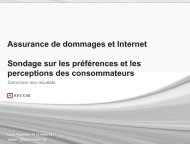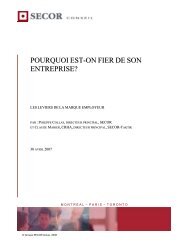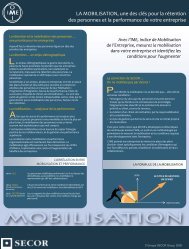La mobilisation du personnel - secor
La mobilisation du personnel - secor
La mobilisation du personnel - secor
Create successful ePaper yourself
Turn your PDF publications into a flip-book with our unique Google optimized e-Paper software.
MOBILIZATION: One of the keys to retaining talent<br />
and enhancing your company's performance<br />
Retaining and mobilising talent<br />
A business priority<br />
Nowadays, mobilizing and retaining talent is one of the highest<br />
corporate priorities.<br />
Retaining… a demographic issue<br />
emographic issues, the fight for good talent and the lack<br />
of high‐potential candidates, mean that companies are paying<br />
particular attention not just to recruiting but to retaining talent<br />
as well. Mobilization represents a major challenge in talent<br />
retention.<br />
Most companies have become aware of these issues and have<br />
implemented action plans and tools that take the expectations<br />
of talent into account and ensure their loyalty: integration<br />
programs, performance review, succession plans, work‐climate,<br />
satisfaction and compensation surveys are all indispensable<br />
management tools and levers of course, but they do not<br />
guarantee mobilization, the key factor in talent retention.<br />
Mobilization… a performance catalyst<br />
I<br />
n an ever‐increasing race to higher performance, and in a<br />
world of continually rising competitive pressures, resource<br />
mobilization is still an underexploited lever because it is poorly<br />
understood.<br />
A mobilized company is able to capture its collaborators'<br />
positive energy and generate superior performance.<br />
The correlation between mobilization and organizational<br />
performance has been amply proven. Mobilization has an<br />
immediate effect on a company's revenue growth, cost<br />
optimization and profit increase.<br />
CORRELATION BETWEEN<br />
MOBILIZATION & PERFORMANCE<br />
You can determine your internal<br />
mobilization index and identify the<br />
conditions needed to mobilize your<br />
talent by using the OMI<br />
(Organizational Mobilization Index)<br />
SECOR is convinced that there is no such thing as<br />
mobilization by decree<br />
or SECOR, mobilization is not established by decree …it<br />
develops when conditions are right:<br />
> The meaning that peole find in their work based on their<br />
knowledge of the strategy, the alignment of the objectives<br />
and the feeling of giving priority to the client, the client being<br />
the company's source of revenue,<br />
> The creation of a motivating work climate by empowering<br />
and recognizing employees,<br />
> A management style that provides meaning and creates a<br />
climate favourable to motivation.<br />
That is why SECOR developed the OMI tool that it has been<br />
using for several years: this is a tool and a methodology that<br />
helps companies measure the mobilization levels and determine<br />
what conditions are needed to develop mobilization within the<br />
company.<br />
The OMI enables companies to implement action plans<br />
specifically designed to foster the emergence of conditions<br />
lacking yet needed to improve mobilization levels among the<br />
<strong>personnel</strong>.<br />
THE MOBILIZATION EQUATION<br />
2004 ‐ CLC Mobilized employees perform 20% above demobilized<br />
ones. The only issue: Mobilized employees represent only<br />
28% of the <strong>personnel</strong>!<br />
2004 ‐ Bates<br />
(Study on Sales Forces)<br />
2005 ‐ SECOR<br />
(Study on retailers)<br />
Performance gap is 25% between mobilized and<br />
demobilized employees and 98% between very mobilized<br />
and very demobilized ones!<br />
The most mobilized 12 stores have also the strongest sales<br />
growth rate and the best margin per square foot!<br />
MEANING<br />
MANAGEMENT STYLE:<br />
A LEVER<br />
MOTIVATION<br />
© Groupe SECOR Group, 2009
Since 1998, thanks to the OMI tool, SECOR has been measuring<br />
mobilization and coaching its clients on their action plans<br />
What is the OMI?<br />
The OMI is a proven tool that guarantees reliable,<br />
quality results<br />
ECOR developed both the tool and the methodology based on<br />
research on mobilization.<br />
It has been established that mobilization is a function of meaning,<br />
motivation and managerial capacities. The OMI looks at these elements<br />
and measures them along four dimensions: Strategic alignment, Client<br />
vision, Empowerment and Regard, each of which breaks down into two<br />
or three components (see figure below).<br />
The OMI is a management tool that serves to:<br />
> Identify the level of mobilization throughout the four dimensions<br />
> Measure this level of mobilization for different <strong>personnel</strong> categories:<br />
employees, professionals, technicians, etc.<br />
> Measure how the relationship with external clients influences the<br />
level of mobilization<br />
> Identify the constraints and the opportunities that influence<br />
<strong>personnel</strong> mobilization<br />
> Compare your organization with a benchmark group<br />
> Act<br />
he tool is statistically proven and has been administered to many<br />
companies and to than 100,000 respondents.<br />
Questions:<br />
> Articulating the question: make it clear and concise<br />
> Standardize terminology (e.g. "my unit", "top management")<br />
> Customized questionnaire (e.g. “L’Oréal”, instead of "my<br />
company")<br />
> Two questionnaires, each with its own wording:<br />
Manager: what I think the <strong>personnel</strong> thinks<br />
The <strong>personnel</strong>: what I think<br />
The results are interpreted as a mirror effect: are the managers<br />
really aware of the situation?<br />
Presentation and assembly:<br />
> Clear instructions on the first page<br />
> Randomly placed questions to avoid a "halo" effect (questions<br />
are not grouped by theme)<br />
> Each component has 3 questions or more to guarantee a valid<br />
statistical analysis<br />
> The questionnaire is short and has a maximum of 60 questions<br />
1. Strategic alignment<br />
• Strategic direction<br />
• Objectives alignment<br />
Bearers of<br />
meaning<br />
2. Client vision<br />
• Client commitment<br />
• Understanding of the market<br />
• Ease of the client relationship<br />
Understand the issues,<br />
orientations of the organization,<br />
changes, and have clear<br />
objectives<br />
Have the means to do one’s<br />
work, be autonomous and<br />
responsible for the results<br />
Strategic<br />
alignment<br />
Empowerment<br />
OMI<br />
Client vision<br />
Consideration<br />
Perceive a client culture that<br />
translates into actions, know<br />
and satisfy the client<br />
Feel considered and valued by<br />
management and managers,<br />
work in a trusting environment<br />
3. Empowerment<br />
• Support<br />
• Cooperation<br />
• Autonomy<br />
Levers of<br />
motivation<br />
4. Consideration<br />
• Sense of worth<br />
• Trust<br />
• Recognition
As participants, you have access to reports allowing you to see<br />
your overall level of mobilization, the reasons behind it,<br />
how you are positioned with respect to the market, etc.<br />
The<br />
deliverables<br />
> A customized summary report<br />
> A presentation of the overall results<br />
> Your positioning with respect to the market<br />
> Each organization receives a detailed report. Complementary analyses of the results can be provided<br />
upon request<br />
Excerpts from the report provided to participating organizations<br />
Overall index<br />
My company's overall level of mobilization<br />
Is mobilization balanced?<br />
The reasons behind the overall level of mobilization<br />
Excellence<br />
Zone<br />
OMI INDEX<br />
LEVEL<br />
80<br />
70<br />
60<br />
EMPLOYEE<br />
BEHAVIOR<br />
Model<br />
Dedicated<br />
Strategic<br />
alignment<br />
25<br />
50<br />
Acceleration<br />
Zone<br />
Start‐up<br />
Zone<br />
+27<br />
40<br />
30<br />
20<br />
10<br />
-10<br />
0<br />
Committed<br />
Involved<br />
Functional<br />
Regard<br />
28<br />
Empowerment<br />
38<br />
Urgency<br />
Zone<br />
-20<br />
-30<br />
-40<br />
Resistant<br />
Deviant<br />
Client<br />
vision<br />
2<br />
40<br />
30<br />
Your organization's results<br />
compared to the benchmark<br />
An indicator of my positioning compared to the market<br />
31<br />
39<br />
35<br />
The answers to the questions<br />
Strategic alignment –<br />
STRATEGIC DIRECTION<br />
The level of understanding of the strategy, changes and<br />
adaptations measured by the clarity of communications<br />
20<br />
17<br />
20<br />
26<br />
22<br />
22<br />
522<br />
2. Top management clearly expresses my<br />
organization's business direction<br />
52% 9% 43<br />
10<br />
525<br />
14. I receive clear information on my<br />
organization's performance<br />
53% 7% 46<br />
0<br />
OVERALL<br />
INDEX<br />
1<br />
Strategic<br />
alignment<br />
Client<br />
vision<br />
Empowerment<br />
9<br />
Regard<br />
Your<br />
company<br />
The<br />
benchmark<br />
526<br />
526<br />
17. Top management clearly expresses the<br />
reasons for changes in my organization<br />
22. My organization quickly adapts to meet<br />
clientele needs<br />
35% 17% 18<br />
23% 21% 2<br />
Other data found in the report<br />
> The barometer, an advanced indicator of the<br />
climate<br />
> The results by component (Strategic direction,<br />
Objectives alignment, Client vision, etc.)<br />
> A recap leading to an initial diagnosis<br />
> Results by category (managers, employees, etc.)<br />
> Results by group<br />
> Results by age<br />
> Results by seniority<br />
> Results by gender<br />
> Results by component by department
Multiple benefits both in terms of organizational performance and talent<br />
retention: measure and compare to understand and act<br />
A structured process<br />
Continuous coaching<br />
PHASE 1 PHASE 2<br />
PREPARATION<br />
ADMINISTRATION<br />
PRESENTATION AND ROLL-OUT<br />
PROJECT LAUNCH<br />
1<br />
Orientation<br />
and Adaptation<br />
2<br />
Validation<br />
SURVEY LAUNCH<br />
3<br />
Processing<br />
and Analysis<br />
4<br />
Presentation<br />
of results<br />
5<br />
Roll-out<br />
ASSESSMENT<br />
QUESTIONNAIRE<br />
• Adaptation of the<br />
questionnaires<br />
• Definition of the<br />
respondents<br />
• Demographic criteria<br />
• Supplemental<br />
questions<br />
• Questionnaire<br />
• Presentation letters<br />
• Communication plan<br />
• Monitoring of<br />
response rate<br />
• Reminder(s)<br />
• Data entry and<br />
processing<br />
• Validation of data<br />
• Preparation of reports<br />
• Analysis of results<br />
• Presentation<br />
timetable<br />
• Communication of<br />
results<br />
•Training<br />
• Action plan(s)<br />
PROCESS<br />
• Prior communications<br />
• Choice of<br />
administration<br />
method<br />
• Timetables<br />
Benefits to you<br />
> Measure your capacity to mobilize your <strong>personnel</strong><br />
> Identify priorities and actions to implement to create<br />
conditions con<strong>du</strong>cive to high mobilization levels<br />
> Compare your practices to other companies of your size<br />
and/or that are established in your market<br />
> Have a tool that can improve your performance and your<br />
capacity to retain talent<br />
> Use the survey to get your HR network focused on your<br />
issues<br />
For information, contact…<br />
info_ime@groupe<strong>secor</strong>.com<br />
SECOR, with more than 100 consultants, and offices in<br />
Montreal, Quebec, Paris, New York and Toronto is the largest<br />
independent consulting firm in Canada. Founded in 1975,<br />
SECOR has more than 30 years of experience in providing<br />
strategic and managerial support to large corporations.<br />
www.<strong>secor</strong>group.com<br />
Montréal<br />
555, René‐Lévesque Blvd. West<br />
9 th Floor<br />
Montréal, Québec<br />
H2Z 1B1<br />
Tel: 514‐861‐9031<br />
Fax: 514‐861‐0281<br />
New York<br />
1370 Avenue of the Americas<br />
14 th Floor, suite B<br />
New York, NY 10019<br />
Tel: 212‐307‐0020<br />
Fax: 212‐307‐0084<br />
Paris<br />
50/50bis rue Saint Ferdinand<br />
75017 Paris<br />
Tel: +33 (0)1 56 26 57 27<br />
Fax: +33 (0)1 56 28 03 43<br />
Québec<br />
2600 boul. <strong>La</strong>urier<br />
Bureau 955, 9 e étape<br />
Tour de la Cité ‐ entrée 6<br />
Québec, Québec<br />
G1V 4W2<br />
Tel: 418‐653‐5335<br />
Fax: 418‐657‐7571<br />
Toronto<br />
390 Bay Street<br />
Suite 2400<br />
Toronto, Ontario<br />
M5H 2Y2<br />
Tel: 416‐362‐0505<br />
Fax: 416‐362‐6804





